Prashanth Kamalakanthan is a writer and filmmaker who lives in Brooklyn. Originally from Tirupati, India, he grew up in North Carolina and studied film, political science, and environmental policy at Duke University. He curates a feed of film stills @motionstillness.
We ask that the reader open images in new tabs to fully experience them.
By age 30, Turkish filmmaker Nuri Bilge Ceylan had done a lot of things besides make films. He had left his childhood home in the countryside and started college during the turbulent 1970s, when Istanbul’s campuses were at the center of the political clashes consuming Turkey. As an engineering student, he’d biked across Italy, and after graduating he’d hiked the Himalayas. He had completed his military service, shot photographs professionally, and become the oldest student at Mimar Sinan University’s film school. Within two years, he had dropped out, too.
It wasn’t until he was 34 that Ceylan finally began shooting his first film, using a scrappy combination of Russian negatives and some long-expired domestic film stock. Two years later, that film, Koza (Cocoon), became the first Turkish short screened in competition at Cannes. Nine years after that, Ceylan walked away with the top prize at that same festival, for his seventh feature Winter Sleep, which debuted in the U.S. on December 19.
It’s been a long wait, but then, maybe more than any other working director, Ceylan (now 55) is studiously patient. His films move slowly (the latest clocks in at 196 minutes), offering little action or suspense. Ceylan’s subjects are instead often caught in stillness: pictured from the back, watching the grass in the wind; studying a relative, a lover, a friend, unsure of what to say next. In such moments of repose, French director Jean Renoir once wrote, “It is not the transitory character of an individual [that is] fixed in marble, but his whole general character, the culmination of his entire life.”
Ceylan’s greatest gift, perhaps acquired in the course of his own tortuous career, is in taking this long view in all aspects: wide shots, long takes, and subtle, overarching social critique. From these emerges a kind of compassionate filmmaking with few contemporaries in world cinema, a devotion to understanding humanity that’s palpable in every instant.
Maybe the most memorable moment among Ceylan’s films comes early in his third feature, Uzak (Distant), a quiet story about a pair of cousins in Istanbul. Laid-off factory worker Yusuf—played by Ceylan’s real-life cousin, Mehmet Emin Toprak—has arrived from the countryside to live with the older Mahmut, a commercial photographer, while he looks for work. On one of the first nights they spend together, we see the two watching Mahmut’s VHS copy of Andrei Tarkovsky’s Stalker (1979) in the living room. Bored and sleepy, Yusuf retires for bed. Soon after, Mahmut switches tapes and begins watching porn.
The scene might seem like a jab at the famously difficult Russian director, but its meaning is deeper than that. It’s a shimmering of Ceylan’s broader philosophy, how he may have managed to surpass the limitations of his greatest influence. As he recently told the Guardian’s Peter Bradshaw, “There is not such a long way between Tarkovsky and porn. Both of these are coming from our needs.” To equate Tarkovsky’s unwavering exploration of human spirituality—the search for meaning in life and the suffering this entails—with pornography gestures toward a mutual influence of the two filmmakers, that long tradition of Russian literature beginning with the work of Dostoevsky. (As the novelist Kaya Genç points out, Turkey’s cultural ties to Russian literature run deep, owing much to the geopolitics of its location.)
And there it is in Uzak, brought together in one unbroken shot. The film is on the one hand “a criticism of how we live in cities,” as Ceylan explained shortly after its release. “I see how my intellectual friends live in Istanbul; their hopes fade and they have nothing to turn to. In villages, people help each other…in city life, people are more reserved. We create our own prisons.”
Still, it’s no polemic against city dwellers, or those unable to set aside their animal impulses to pursue higher ideals, a target even Tarkovsky couldn’t resist taking aim at. Saints and sinners alike cause suffering; even the Buddha, Ceylan might point out, first left his family. The point is to be present and aware of one’s own faults as well as the external conditions that exacerbate them, “to try to understand what it means to be human.”
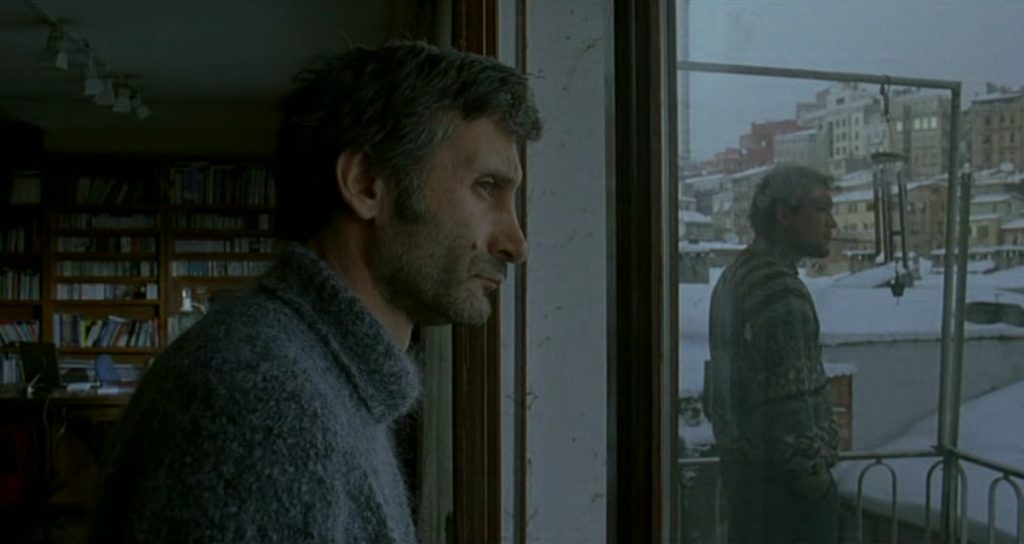
Yet it’s clear which world—internal, external—is the strongest force in Ceylan’s universe. Though each of Uzak’s characters is unflinchingly portrayed in all his faults, most at blame is no single individual but rather the society that encompasses them. This seems to be true of all of Ceylan’s films. Both cousins’ problems, after all—Mahmut, the cynical, unengaged artist, forced into boring commercial work, and Yusuf, the kindhearted but coarse country boy unable to find the most menial labor—are rooted in broader social failings.
In this light, Ceylan’s work takes on a deeply radical political valence, although there’s no explicit politics in any of them. What Tarkovsky wrote admiringly of Luis Buñuel is equally applicable in Ceylan’s case: “His protest—furious, uncompromising, and harsh—is expressed above all in the sensuous texture of the film, and is emotionally infectious…not calculated, not cerebral, not formulated intellectually.”

The cousins stumble across a stunning landscape, but Mahmut doesn’t bother to set up the camera, calling it a “fucking waste of time.” From Uzak (2002).
It’s unsurprising, then, that there are no great villains in Ceylan’s films. Even the vilest have the capacity for great good inside them, and the most outwardly upright are often blind to the suffering they cause. This totalizing, nonpartisan view of humanity is one that’s more Chekhov than Dostoevsky, and consciously so. Ceylan claims to have been reading Chekhov since he was a teenager, and his latest two films lean heavily on the author’s short stories. His intensely personal first four films also share this sensibility, if for the simple fact that they’re all semi-biographical, starring either Ceylan himself or close relatives.
The self-absorbed filmmaker protagonist in Clouds of May (1999), for example, beautifully embodies Ceylan’s own failings as a son, blind to the travails of his parents (played by Ceylan’s real-life parents) even as he casts them in his film. That film, Ceylan’s second, is a reflection on his behavior during the production of his debut feature, Kasaba (The Town), in 1997, in which Toprak and his parents first starred. Uzak’s Mahmut is a stand-in for Ceylan, who continues to work as a photographer today. And his icy portrayal of a fraying, uncommunicative couple in Climates (2006) stars Ceylan himself alongside his real-life wife (and regular co-writer) Ebru Ceylan.


Along with Uzak, all four early films evoke the work of Japanese director Yasujirō Ozu, a stated influence of Ceylan’s. The pair are masterful in their handling of the domestic milieu, subtly portraying the banality of cohabitation as well as how profoundly transformative it can be, at unexpected and unpredictable moments. Unlike Ozu, however, who set his family dramas largely amid traditional Japanese society, Ceylan is a child of modern Turkey, in all its Westward-oriented alienation, isolation, and narcissism. In that basic sense, Ceylan tends toward another directorial influence of his, the Italian “photographer/director” Michelangelo Antonioni. Where Ozu took granted people’s capacity for guilt in a normative, traditional society, Ceylan borrows Antonioni’s key insight: guilt and its motivator shame share the prerequisite of self-consciousness, an at least basic awareness of one’s own faults. But that awareness is slow in coming when people are trapped in “their own prisons,” blind to the suffering they cause.
The astonishing maturity in Ceylan’s early handling of human characters is partially by design. It’s hard to attack someone when they’re based on or played by you, your wife, your cousin, your parents. But the effects of mixing real life and fiction in this way are complex. The case of Mehmet Emin Toprak, Ceylan’s once-favorite actor, is a tragic example. Like his character in Uzak, Toprak actually worked at a small-town ceramics factory while he starred in his cousin’s films, taking periodic leaves to act. At 28, he had bought a second-hand car with his payment from Uzak and was driving back from the film’s screening at the Ankara film festival when he died in a crash. He posthumously won Best Actor for his performance at Cannes, and Ceylan can hardly be held accountable for Toprak’s death—but the circumstances were undeniably set in motion by the filmmaker, a fact that he has long suffered for. “I don’t like to go back home to Yenice anymore. I feel so bad, so guilty,” he said in 2004.
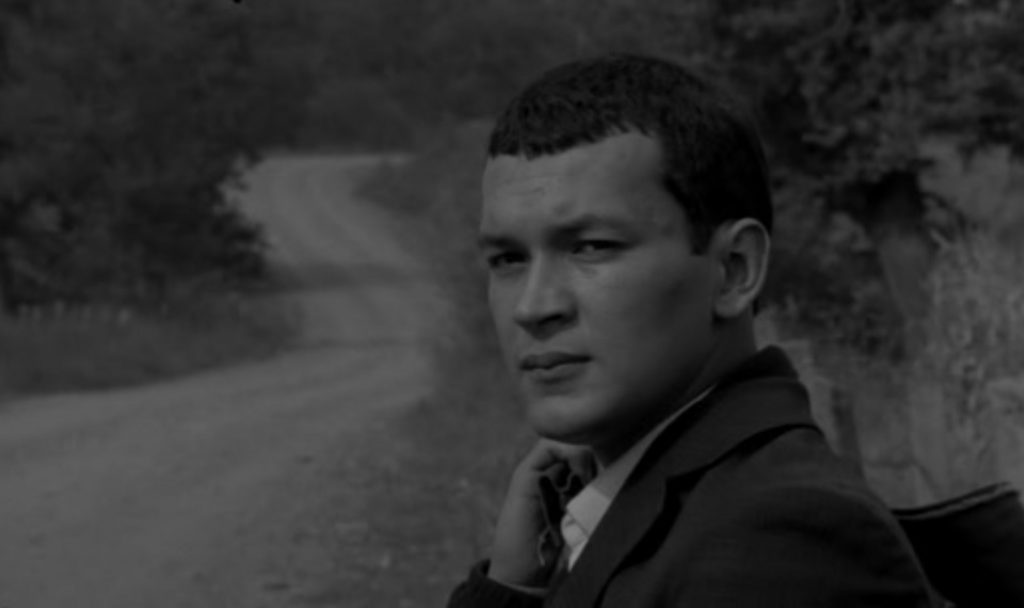
As with Satyajit Ray’s debut Pather Panchali (1955), Ceylan’s first feature, Kasaba (1997), is a film about leaving the village for the city. Above, Toprak looks back one last time.
This theme of guilt is precisely what carries over most discernibly into Ceylan’s post-autographical period, beginning with 2008’s Three Monkeys. The film traces a full cycle of guilt: a wealthy businessman pays his driver to take the fall for his accidental killing of a pedestrian, and the driver’s son’s vindictive murder of the businessman prompts the driver to propose the same arrangement to another man.
Ceylan’s trademark photographer’s style—executed by cinematographer Gökhan Tiryaki beginning with 2006’s Climates, in which Ceylan co-starred (and thus couldn’t shoot, as he did his first three features)—also reaches a remarkable proficiency in his later films. The shots last longer and cut fewer times to capture details, preferring the broader scope. Large, painterly tableaux with impeccable compositional balance appear with increasing consistency. Camera moves are rare, persistently downplaying any potential for drama in favor of studied observation. Form and content converge: perspective, plurality, and patience.
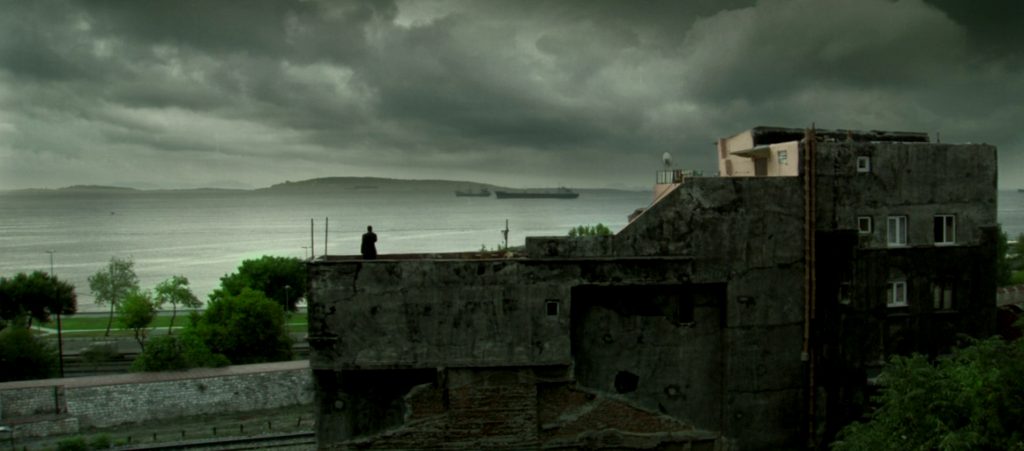
Taken together, these elements of Ceylan’s work comprise what could be called a “vertical” kind of filmmaking. Little may happen on the surface, but then these are not films driven by discrete events—a “horizontal” progression—but rather by the deepening of the human characters in relation to themselves, each other, and their environment. Protagonists are not swept up in an epic narrative, the Hollywood style: they are, instead, prime movers in a fairly basic plot, revealing with each subtle action, each tiny gesture, a truer picture of who they are.
Apart from his recently-released Winter Sleep, 2011’s Once Upon a Time in Anatolia is maybe Ceylan’s most masterful work yet, his strongest realization of this vertical sensibility. In it, a motley crew—a doctor, a prosecutor, district police, diggers, some gendarmerie, and a pair of suspected murderers—drive through the gorgeous landscapes of the Anatolian hillside, looking for a buried body. They find the dead man, file a report, and perform an autopsy. That’s about it, plotwise—but in characters and theme, it’s an acutely thoughtful, elliptical return to the idea of guilt. The man who at the beginning of the film has confessed to a murder is made more sympathetic as the film progresses, while the upright investigators around him move the opposite way, intensifying their own guilt by word and deed.
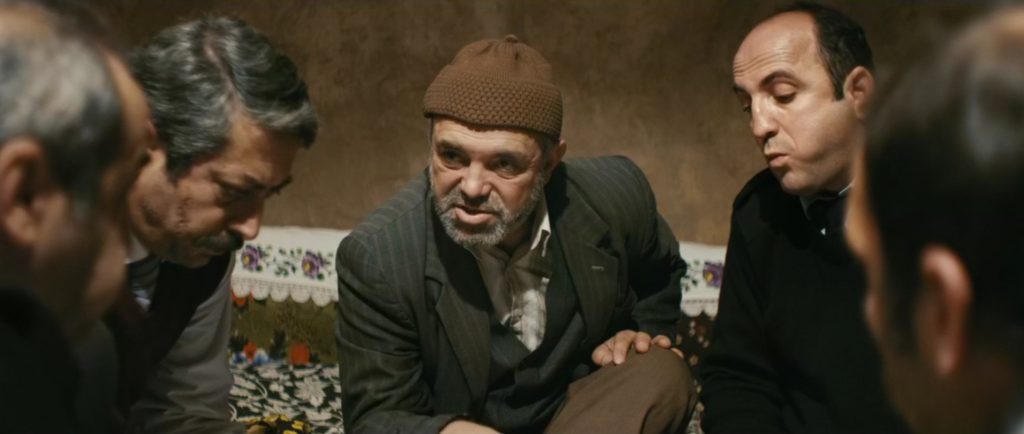

The approach may seem slow, but it’s not in any way static. It is, simply, the way normal life feels. Like Tarkovsky, Ozu, Antonioni, Satyajit Ray, and others before him, Ceylan revels above all in the small, surprising, moments: apples rolling down a hill, water shimmering, candles wavering, inconsequential discussions about yogurt and lamb meat. These non-narrative stretches in a film may cultivate a kind of boredom. But they are, I suggest, a rich kind of boredom. On the one hand, however uneventful, you are watching beautiful observations of life unfold. Beyond that, though, these scenes carry a sense of eternal truth: what experimental filmmaker Nathaniel Dorsky calls “self-symbol.” Such “observation-images,” as Tarkovsky wrote, are “innocent of symbolism,” no self-confirmation of anyone’s genius in setting or solving a puzzle. They are just fixed moments from a life as actually lived, fleshing out a fuller understanding of the present in its infinite causes and consequences.

That observation-images “lead” to nothing helps in this potential understanding: there’s nothing else for the viewer to do but to contemplate them as they are. During these stretches, characters and viewers alike retreat into their heads, free to reflect on their present reality and their role in it. There is, of course, the risk of boredom, but the opposite approach, filmmakers like Ceylan might argue, is much more morally fraught.
The plodding along of a three-act plot is so akin to a life overbooked. When everything is planned or predictable, you no longer need to consider who you are, the full consequences of your actions. You become yet more flotsam in the wave. Put another way: planning how to act, then doing it, tells you nothing about yourself and everything about the expectations you have been socialized into, in an often abhorrent society. Left to make your own way in an unfamiliar place: then there’s an opportunity for self-understanding, for growth. And growth—in the full, human sense—might be the most important task of all.




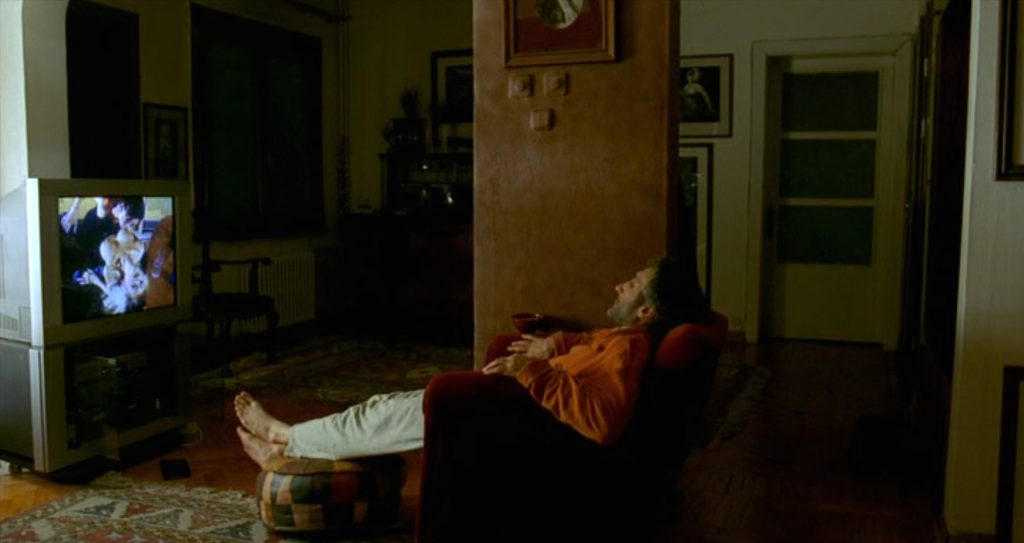










1 comment
This piece is such an extremely sensitive insight to the humanity of Ceylan’s work, free of the cant and academic jargon that sometimes smothers film criticism. And you know how to talk about “images.” Thank you.